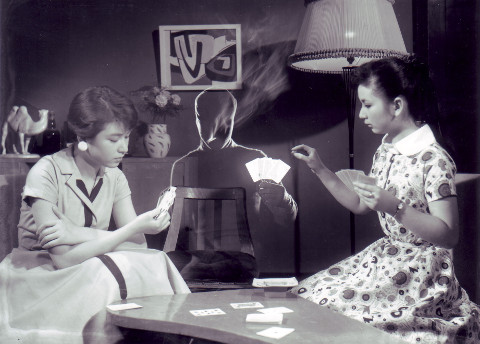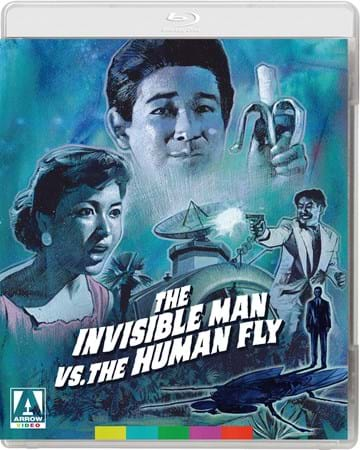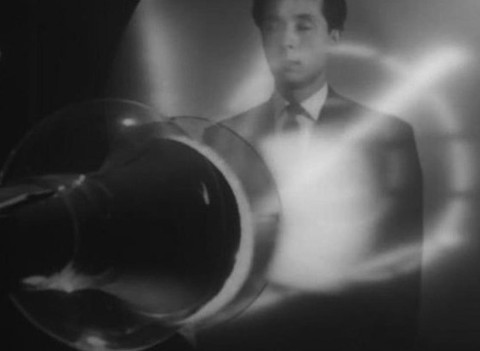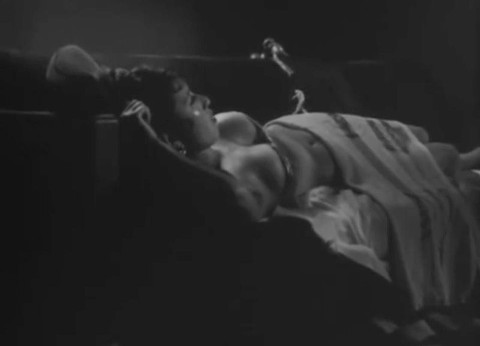The Invisible Man Appears, The Invisible Man vs. The Human Fly (1949, 1957)
Directed by: Mitsuo Murayama, Shinsei Adachi
Written by: Akimitsu Takagi, Hajime Takaiwa, Nobuo Adachi, Shigehiro Fukushima
Starring: Chizuru Kitagawa, Daijirô Natsukawa, Junko Kanô, Ryûji Shinagawa, Takiko Mizunoe, Yoshirô Kitahara
Gojira aka Godzilla from 1954 is generally regarded as the first Japanese science fiction film, but actually it’s not. It was preceded by these two efforts from Daiei, which were in turn preceded by two King Kong films made by Toho in the ‘30s. Now I would give my right arm to see the latter, but they seem to be lost. What aren’t lost, though, are these two Invisible Man films. Arrow Video’s Blu-ray is, incredibly, the first time they’ve been released outside of Japan, so you can imagine how excited I was to see them. Background information on them seems scarce, though I don’t have time to do my usual research on these anyway as it’s a very busy review period for me right now. So on with the films….
AKA TOMEI NINGEN ARAWARU
JAPAN
AVAILABLE ON BLU-RAY: 15TH MARCH, from ARROW VIDEO, with THE INVISIBLE MAN VS. THE HUMAN FLY
RUNNING TIME: 87 mins
REVIEWED BY: Dr Lenera

Dr. Kenzo Nakazato has found the secret of invisibility, even though he’s promised his daughter Machiko to which of his two main students Kyôsuke Segi and Shunji Kurokawa achieves this same goal. However, he has no antidote, and the potion turns the drinker violent, so Nakazato isn’t ready to go public with his findings. But then Nakazato and Kurokawa both disappear and Kobe begins to be pestered by an invisible man who seems to be after a particular necklace….

The Invisible Man Appears [it seems like a daft title though you could also say that it’s technically true!] plays very much like part of the Universal Invisible Man series that began with James Whale’s superb comedy-horror The Invisible Man in 1933. That led to an Invisible Woman and an Invisible Agent, but this Japanese film was quite clearly inspired by a viewing or two of The Invisible Man Returns and The Invisible Man’s Revenge in addition to of course The Invisible Man. The plot is a bit more complex with some turns and a fair bit of withholding of information from the audience, the visual style closer to the film noir of the time, and was there a film outside of Lady Of The Lake that employed as much POV of one person [which almost gives bits of the film the feel of a slasher movie!]? However, many elements from those three films are repeated, and even the title character’s bandaged look is almost the same as John Hall’s in The Invisible Man’s Revenge. Tsuburaya’s effects were clearly achieved using the same methods as Universal, though in some cases are a little behind – but let’s not forget that Tsuburaya was just starting out as a special effects artist here, so we can surely make allowances for some of his work not being quite up to scratch? Of course there’s the usual moral element, though the typical warning about mankind’s reach exceeding his grasp in terms of scientific research is replaced by a simpler, “Science isn’t good or evil, what matters is how you use it”, stated in text at the beginning and the end to make sure that we get it. I wonder if they had to play it safe because of the American occupation forces? But the film, if never actually thrilling, is pretty fast paced except when we’re treated to lengthy portions of a revue one of the characters Ryûko Mizuki is in, and succeeds in making you both have sympathy for and be frightened of its invisible man, consequently ending with a climax that has some emotion.
The script by Akimitsu Takagi and Nobuo Adachi pulls off a neat surprise early on. We begin with our three scientists, Kyôsuke Segi and Shunji Kurokawa beginning to argue about each ones preferred method to discover how to cause invisibility. Segi is working on a paint that’s so black that it lets no light bounce off it, the logic being that everything we see is actually light bouncing off something. This means that if something is black enough, it will absorb all light and become invisible. No, it doesn’t make much sense to me either, but never mind, he’s a scientist so must know what he’s talking about. Kurokawa, on the other hand, is working on something more typically mad scientist-style – a potion, and one that allows all light to quickly pass through it. These two are in love with Nakazato’s daughter Machiko, and have already proposed to her with no luck with no success, though she prefers Segi. We think that the story is going to be about the race of these two with their mentor taking a back seat, but then we find out that Nakazato has already succeeded in creating invisibility using Kurokawa’s method! This clues one in to the idea that the plot of this film may have a few more surprises than you might expect. Nakazato reveals his invention to his businessman friend Ichirô Kawabe at the same time as his wife wonders why she can hear their cat but not see it. Kawabe already seems to be thinking sinister thoughts and doesn’t look that happy when Nakasato doesn’t let him have the rights to his project. Kawabe also seems fascinated by this diamond necklace he sees in a shop, and soon after this Nakasato and Kurokawa both disappear.
You could probably work out some of what going to follow, but certainly not all of it. When an invisible man starts to make headlines, it seems like it’s probably either Nakasato or Kurokawa, and we can also guess that a certain other person is involved, though could it be possible that we’re being led a little down the wrong path? There’s some rather careless plotting which I’m surprised got passed, most notably in terms of the invisible man. He’s constantly after this necklace, but misses several ways in which he could use his invisibility to take the thing and run. For example – surely he could sneak into a room, wait for the person holding the necklace to dial the code on the safe, memorise said code, wait until the person is gone, then simply open the safe and take the diamonds. Bingo! Instead, he prefers to announce his presence and employ his fists and a gun to solve matters. He’s not very bright this invisible man – or maybe he’s just developed a huge ego, which I suppose is possible seeing how, like most invisible men, the potion is also effecting his mind. But then we have the revelation of what’s actually going on which makes one ponder on how incredibly naive the person who becomes invisible is; the ruse he falls for is absurdly obvious. Still, while there’s quite a lot I’m not going to reveal, it’s interesting having an invisible man who’s controlled by someone else. And the really packed story also crams in the likes of copycat invisible men, a fake necklace in addition to the real one, and a conveniently found doctor’s notebook, while the final act has one female character suddenly take matters into her own hands as well as engage in the most heartrending exchange in the film as she tries to get the invisible man to regain some of his sanity. We’re emotionally invested enough by now to really care, even if things do wrap up in a fairly expected fashion which nonetheless makes sense of the film’s very first image.

A lot of the invisible man footage is from his point of view, which in addition to saving on the special effects budget adds a darker edge to what is generally clearly a family-aimed feature and sometimes implies us in the violence he’s dishing out. The technical side of things certainly gets off to a good start when lots of things are knocked down by an invisible cat featuring good wirework, and then we’re treated to a recreation of the 1933 film’s showstopper when the bandaged invisible man takes everything off. This looks like it was done the same way, by layering multiple prints of the film, one of them in an all-black velvet non-reflective set, with two different exposures. The matte lines are slightly wavier, and Tsuburaya doesn’t really pull off a sequence where the clothes and the hat are being worn but we don’t see the head; we see a fair bit of blur where the head would be. But one can still admire the craftmanship behind this kind of thing in these days when virtually everything is rendered on a computer and doesn’t always look much better anyway. The famous smoking gag looks impressive, and a scene where the invisible man scares a very drunk person and takes his clothes combines humour and fear quite well even if it’s such an obvious situation. Unfortunately the scenes where other people are getting knocked about by the invisible man are rather clumsy and belong in something like an episode of the ’60s Batman TV series [which I do love by the way, but this film is surely meant to be reasonably serious], and you even get to see somebody lifting himself up by his own suit collar! There’s also an odd moment where we don’t hear the sound of a car when we clearly should. Maybe post production was rushed?
Still, the movie in general looks good [as far as one can tell, see below], the camera of Hideo Ishimoto is fluid as it moves around characters and rooms even if it doesn’t seem to like closeups, and there are some nice process shots of the necklace reflected in faces. The use of location footage is one thing where it really differentiates from the Universals, adding a feel of realism despite the fantastical nature of the plot. And there’s an unusual montage which is a creative variant on the typical ‘newspaper headline’ stuff you get in films of this vintage and before. The acting is a mixed bag with both blandness and scenery-chewing on offer. Shôsaku Sugiyama is appropriately the latter as Kawabe though after the film has finished you’ll be most left memories of Takiko Mizunoe who has a strong presence throughout even if she does little, and then as her character comes to the fore displays emotive acting which is genuinely affecting. Despite some really good aspects, The Invisible Man Appears never quite reaches the level it sometimes seems to be on the verge of doing, but as a fan of both tokosatsu [Japanese special effects films and TV] and Universal horror movies I still enjoyed it a lot and I think you will too if you like the categories I’ve just mentioned. It’s a very approachable, easy to digest, work, and not at all stilted despite its age, which makes it odd that it’s never been legally available outside it’s native country until now. And, while some may be understandably disappointed by how it all really revolves around a necklace, I always appreciate a film where plain, common greed is the thing that sets everything off. Because – well – doesn’t it almost always?
AKA TOMEI NINGEN TO HAE OTOKO
JAPAN
AVAILABLE ON BLU-RAY: NOW, from ARROW VIDEO, with THE INVISIBLE MAN APPEARS
RUNNING TIME: 96 mins
REVIEWED BY: Dr Lenera

A man is killed aboard a packed jet flight but none of the crew or passengers see or hear a thing. Professor Hayakawa shows fellow passenger Inspector Wakabayashi his new invention; an invisibility ray, though one that’s not without its flaws. Wakabayashi wonders if this is the link to a series of baffling bank robberies and murders and bank robberies, though this fails to explain why one victim died pointing a finger up at the sky, another seemed to be swatting something, and a buzzing sound was heard. Maybe a connection between a sleazy nightclub owner, a friend of his and one of the victims who served together during World War 2 will reveal more….

Despite being made eight years after The Invisible Man Appears, I still assumed that this was a film that had connections to it. Indeed one could probably tweak some of the script so that it follows on from the 1949 flick, even to the point of just adding a few lines of dialogue. But actually it has nothing to do with it, the invisibility side of things starting all over in addition to being a bit different. It’s a significantly odder film than the previous one, though not really worse or better because of this. There’s still much intended seriousness though more humour is clearly intended. The human fly of the title is highly absurd, even it doesn’t contain any fly-like features. You’ll find it hard to stop laughing when you see this tiny person floating around with his arms stuck to his sides, accompanied by a buzzing sound, said floating and buzzing abilities possible, so we’re told, because he’s so small! Science is of course responsible for this, but by contrast invisibility is represented as a force for good just as in Universal’s The Invisible Man Returns in contrast to The Invisible Man, though so much time is spent with these murders [of which there are a hell of a lot] and this precursor to Ant Man that the invisibility angle is diminished considerably, so that for some sections we almost forget about it. Still, the story is fairly well constructed and doesn’t contain the gaping holes of the one in The Invisible Man Appears while still delivering a few surprises, and, while for the most part director Mitsuo Murayama and cinematographer Hiroshi Murai adopt a lighter visual style, there are some tremendously noir-style sequences in an underground tunnel and even some scenes of horror, while the special effects, despite not being by Tsuburaya, are sometimes slightly better, something no doubt due to what looks like a bigger budget being allotted to this one despite still being in black and white.
The first thing I should mention in this paragraph is are the weird electronic wails and jabs heard over the main titles, Tokujiro Okubo’s score being quite unique. This body is found in an airplane cubicle during a flight but nobody saw anyone enter or leave. It’s just one of five recent murders and bank robberies which has the police wondering how on earth the killer was able to get to the victim, kill him or her, then leave. Hajime Takaiwa’s script nicely plays with our expectations here, seeing as we’d expect an invisible man to be behind this; surely nobody else would be able to carry these crimes out totally unseen? “Well, assuming that the perpetrator wasn’t the Invisible Man” says somebody as dramatic music is heard in what is surely meant as a laugh. The building in which scientists are working on these amazing things now looks decidedly futuristic and the main laboratory room very large and full of bits and bobs including a few scaled down mimics of things previously used by a certain Dr. Frankenstein. Here, Hayakawa and company have been investigating cosmic rays and stumbled upon “the imperceptible light ray” and give Wakabayashi a demonstration by making a glass disappear. However, there are problems; anyone using it will only be partly invisible because the ray doesn’t work on exposed flesh, and will then lose his or her life if an attempt is made restore visibility, the latter shown when see a rabbit die in a rather convincing moment which may upset animal lovers. The first point means that the person behind these crimes can’t have used the ray. Wakabayashi follows clues to a nightclub owned by Yamada who seems shady as soon as he says, “just for the record, I have nothing to hide”. There, we’re treated to not one but two dance performances from Ikuko Mori as Mieko, who’s introduced coming down some steps to the stage while the camera focuses for ages on her legs!
The slowish pace gathers speed as the killings begin with a terrific one that’s quite unsettling as a woman walks along a path, the camera focuses on her legs [yes, we have a lot of focusing on female lets in this movie and I can’t say that I have a problem with this even though it would no doubt be complained about if this movie was released today] as two other legs suddenly appear behind her, we cut back to her top half as she staggers having obviously been stabbed, and then her back to show some blood as she falls down dead into some bushes. This is a fine example of how to depict brutal murder while not being able to show much detail, and similar scenes continue in a variety of locations and sometimes in plain sight of others, especially when the human fly, for of course the culprit is he, starts to increasingly enjoy ending lives and bumps off people he doesn’t actually need to. As he says, “they were bimbos and fools, I just got carried away and killed them”. As in the proceeding film, the killer is being used by somebody else, though here to carry out revenge because of something bad being done to someone over a decade ago. Things change though and we even have a train being blown up with some lovely model work that will have Godzilla fans grinning. And the invisible side of things may begin as being rather comical and digressive with one person using the ray and appearing invisible except for head and hands, but does eventually become more important as someone comes up with a bright idea to combat the human fly which involves what you think it will. There’s another wonderful last minute ‘appearance’ by a female character to save the day, after which we conclude not with a warning this time but a jokey and romantic finish, something that makes up for a rather low key climax seeing as it seemed like things were building up to something more spectacular. There’s barely even any of the battling suggested by the title!

There’s not much invisibility special effects work until the final third, but a scene of things being moved and a banana being peeled feature wire work which is incredibly precise, even more so than comparative bits in the first film. The process work in the shots involving just a person’s head is very good indeed and scenes where people are being attacked by something they and we can’t see are definitely superior to what we saw before, especially when an Invisible Man roughs up somebody for information; both the staging and the acting are quite impressive. As for the human fly footage, it varies; sometimes the diminutive being is see-through, sometimes not, but shots of increasing to full human size and shrinking to fly size look really good. Overall I’d say that the effects were slightly above average for the period and the camera doesn’t tend to stay on them for too long either which helps. Shizuo Chujo acts quite powerfully the human fly’s addiction to the drug so that you sympathise with him at times as well as delivering one of the best maniacal laughs I’ve heard in a long time which is just as well seeing how often we hear it. He also gets to carry out what most in his situation would at least consider doing with regard to the woman he’s after, a scene where I was wondering how far it was going to go! Also deliberately amusing [I think] are some banners, shown in another creative montage, with things like FEAR THE HUMAN FLY, YOU COULD BE NEXT and MURDEROUS HUMAN FLY IS TRYING TO KILL YOU. Seeing as we’re currently living in a time where we’re bombarded with messaging to get us to obey certain restrictions because of Covid, I chuckled with some uneasiness.
Acting is generally okay if unspectacular, while the direction is often rather pedestrian except for during the murder set pieces where it seems to come alive while the cinematography in turn becomes more stylised, delivering some lovely noir-ish textures. This one wasn’t made during American rule, so it’s allowed to contain a conversation which clearly relates to the atomic bomb and even ask us to decide whether it was for good or for bad. The back story is a bit like the one in Toho’s similar The Secret Of The Telegian and concerns war crimes and post-war trauma, and I wonder if this is why the proposed US release under the title The Murdering Mite was cancelled. The subject may have been deemed too sensitive for American audiences at the time, especially as it could hardly have been cut out as that would have left big gaps in the narrative, and also as the film was intended to be dubbed and probably aimed at youthful viewers like all Japanese sci-fi back then, even rather more adult efforts such as The H-Men, a film which I wonder may have been influenced by this what with its action in a night club and much lusted after main performer. The Invisible Man Vs. The Human Fly only occasionally gets as insane and thrilling as its title may suggest, and sometimes feels like two different films joined together, one much darker than the other. It’s more uneven than its predecessor but at times and in some areas bests it while retaining many of its elements. I wish they’d made a third….
SPECIAL EDITION CONTENTS
High Definition (1080p) transfers of both films on one Blu-ray disc
The Invisible Man Appears is proceeded by a ‘Best Available Materials’ message, so we know that it’s not going to look very good. And indeed, sourced from a 16mm release print, the warnings of gate weave [wobbling] and blemishes are true. The print shudders and flickers, horizontal lines stay for some time, dirt is frequent. The picture also looks too soft and lacking in some detail and grain, maybe as a result of Arrow trying to clean the image chemically. And yet I don’t think one should complain too much, especially older folk like me who remember the days of obtaining rare films on bootleg videos of terrible quality. The Invisible Man Vs. The Human Fly has the same mostly unrepairable issues as the first, but to not as great an extent, and some sections look rather good. Less chemical cleanup was obviously required so we get more grain and there are times where the picture is quite pleasing.
Original lossless Japanese mono audio on both films
Optional English subtitles for both films
‘Transparent Terrors’, a newly filmed interview with critic and genre scholar Kim Newman on the history of the “Invisible Man” in cinema [24 mins]
Newman appears especially enthusiastic as he talks a bit about the H. G. Wells novel before briefly going through the Universal cycle, these two movies and the recent version of The Invisible Man which was surprisingly good and, as Newman points out, brings a new angle to the table. He wonders if Wells wrote the novel with cinema in mind and says how its existential element was usually simplified to madness, while we’re shown a clip of Sherlock Holmes Baffled, where the great detective meets our unseen friend. We don’t get much information on the Japanese films, but I doubt that much is available.
Theatrical trailer for ‘The Invisible Man Appears’
Image galleries for both films
Reversible sleeve featuring new and original artwork by Graham Humphreys
FIRST PRESSING ONLY: Illustrated collectors’ booklet featuring new writing by Keith Allison, Hayley Scanlon and Tom Vincent
This release is hardly stacked with extras and the films do look ropey due to considerable print damage, but the tokusatsu lover should celebrate that Arrow have, due to their deal with Daiei, been able to release two largely unseen and thoroughly enjoyable [if hardly amazing] films in the genre. Recommended.







Be the first to comment